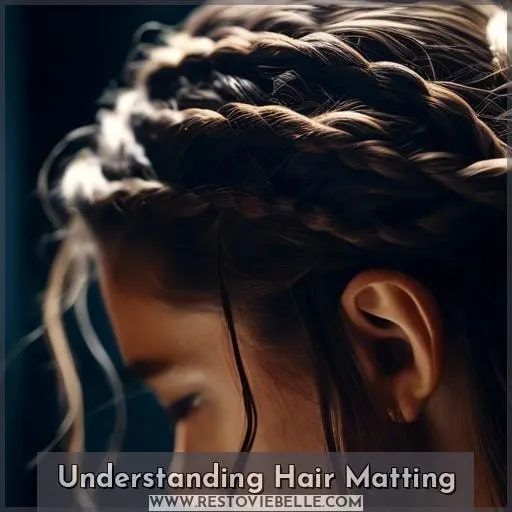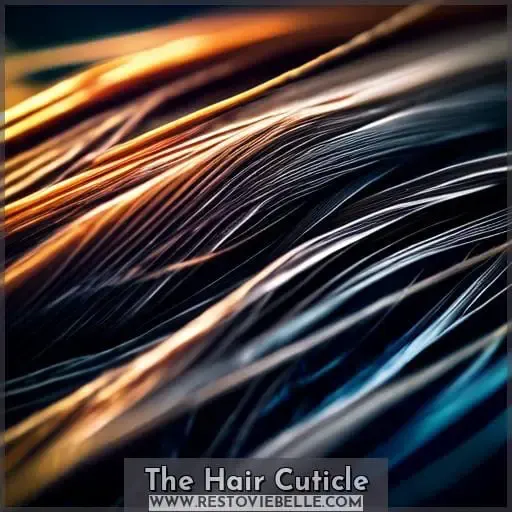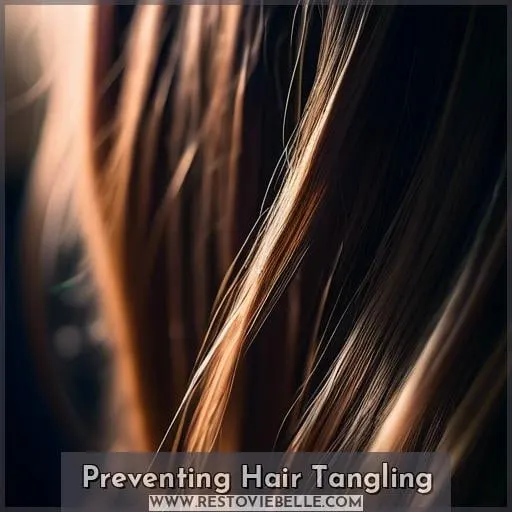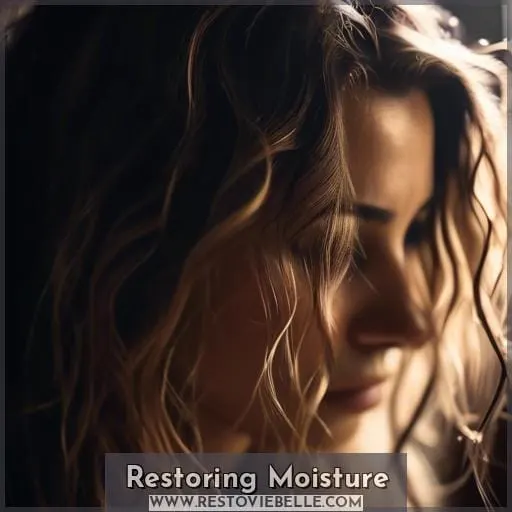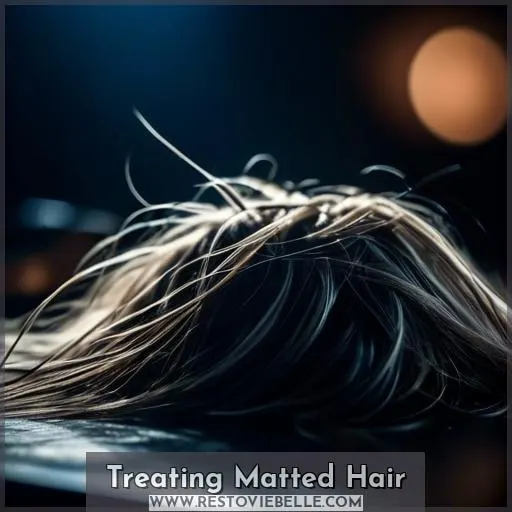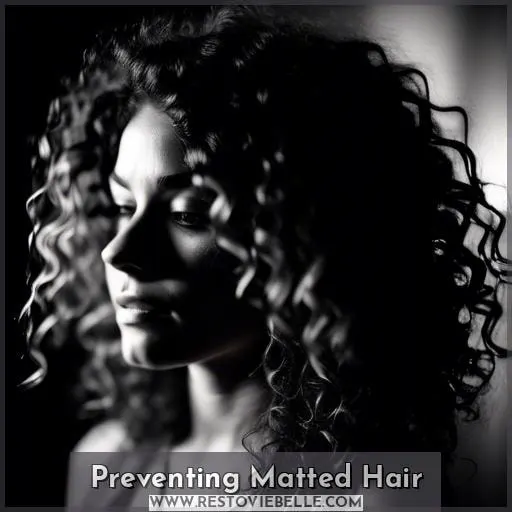This site is supported by our readers. We may earn a commission, at no cost to you, if you purchase through links.
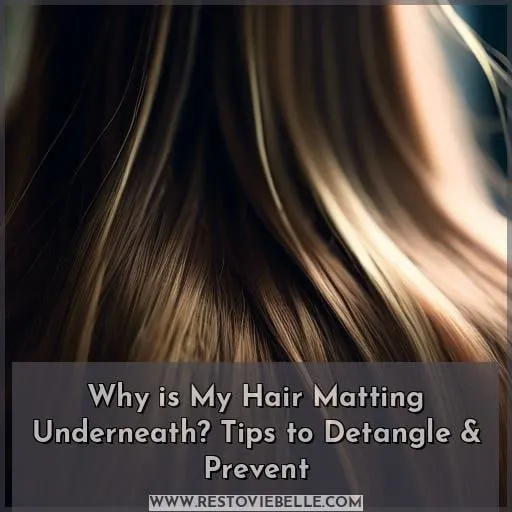 Struggling with hair matting underneath can be a real nuisance, especially when it seems to happen no matter how often you brush.
Struggling with hair matting underneath can be a real nuisance, especially when it seems to happen no matter how often you brush.
If you’re dealing with stubborn knots and clumps at the nape of your neck, you’re not alone. This common issue often stems from a combination of factors like hair type, dryness, and friction.
But don’t worry, there are expert tips and techniques to help you detangle those pesky mats and prevent them from returning. Let’s explore why your hair is matting underneath and how you can keep it smooth and manageable.
Hair matting underneath can occur due to improper care, hair type, and styling practices, such as not regularly combing to remove loose strands, especially in long, curly, or dry hair.
Table Of Contents
- Key Takeaways
- Understanding Hair Matting
- The Hair Cuticle
- Preventing Hair Tangling
- Restoring Moisture
- Treating Matted Hair
- Preventing Matted Hair
- Managing Severe Matting
- Frequently Asked Questions (FAQs)
- Can certain hairstyles contribute to hair matting underneath, and if so, which ones should be avoided?
- How does the texture of hair affect the likelihood of matting underneath, and are there specific textures that are more prone to this issue?
- Are there any dietary factors that can influence the tendency of hair to mat underneath?
- Can environmental factors such as humidity or pollution contribute to hair matting underneath, and how can this be mitigated?
- How does the frequency of hair washing impact the formation of mats underneath, and is there an optimal washing routine to prevent this?
- Conclusion
Key Takeaways
- Hair matting underneath can be caused by improper hair care, such as infrequent brushing, and is exacerbated by certain hair types like curly or dry hair.
- Styling practices like tight hairstyles, friction from clothing, and movements during sleep can contribute to hair matting, as well as a lack of nighttime hair protection.
- The hair cuticle is the outermost layer of the hair shaft that protects against damage and tangles; when damaged, it can lead to increased tangling and knot formation.
- To prevent hair tangling and matting, it is recommended to use silk pillowcases, employ proper detangling techniques, regularly use conditioners and detangling sprays, and minimize friction by avoiding abrasive fabrics.
Understanding Hair Matting
If you’re noticing that your hair is matting underneath, it’s important to understand the common causes and appearances of this issue.
Matted hair typically appears as clumps that are difficult to remove with brushing alone and can be caused by a variety of factors. These include neglected hair care, improper detangling techniques, infrequent hair trims, and lack of nighttime hair protection, which are particularly problematic for those with dry or textured hair types such as curls and coils.
By identifying the root cause of your hair matting, you can take steps to prevent it and maintain healthier, more manageable hair.
Definition and Appearance
Hair matting is a common issue where strands twist and entangle, forming tight clumps that are difficult to brush out. This can occur underneath your hair, particularly at the nape, where friction and movement are frequent.
Matting causes range from hair type, such as curly or high-porosity hair, to external factors like friction from clothing or sleep movements. Underneath reasons for matting include the unique challenges posed by the hair at the nape of the neck, which experiences more friction and can be more prone to dryness.
Prevention methods involve reducing friction and maintaining hair moisture. Silk or satin pillowcases can minimize nighttime hair tangling, while protective hairstyles prevent matting. Detangling techniques are crucial; starting from the ends and working your way up with a wide-tooth comb can help.
Regular use of conditioners and detangling sprays can maintain hair protection and moisture, reducing the likelihood of matting. Additionally, avoiding harsh treatments that increase hair dryness and porosity can help prevent hair breakage and tangling.
Common Causes
Hair matting underneath can be a frustrating and challenging issue, often caused by a combination of factors that lead to the entanglement and knotting of hair strands. Understanding these causes is crucial for both prevention and effective detangling.
One significant factor is hair porosity, which affects how your hair absorbs and retains moisture. High-porosity hair, with its raised cuticles, is more prone to tangling due to its rough texture. High humidity can exacerbate this issue by causing hair to swell and become frizzier, making tangles more likely.
Abrasive fabrics, such as cotton pillowcases or woolen scarves, can increase friction on your hair as you move or sleep, leading to more tangles. Chemical treatments, including dyes and relaxers, can damage hair cuticles, making strands more vulnerable to matting.
Additionally, certain sleep habits, such as tossing and turning or sleeping with loose hair, can increase the likelihood of hair matting underneath. Regular use of detangling and hair conditioning products can help manage these issues, alongside adopting hair-friendly habits like using silk pillowcases and minimizing the use of harsh chemicals on your hair.
The Hair Cuticle
Your hair’s cuticle is the outermost layer of the hair shaft, playing a crucial role in the health and appearance of your strands.
If you’re experiencing matting underneath, it’s likely due to damage to these cuticles. When they lift or tear due to factors like harsh styling, chemical treatments, or friction, they can no longer lay flat, leading to tangles and knots.
To maintain the integrity of your hair, it’s essential to protect the cuticle layer from damage and keep it sealed to prevent matting.
Structure and Function
Your hair’s outermost layer, the cuticle, is crucial for maintaining hair health and preventing tangles. Think of it as the protective armor for each strand, made up of cells that resemble overlapping roof shingles or fish scales.
When these cells lie flat, your hair looks smooth and shiny, and moisture is locked in. However, external factors like chemical damage, heat styling, and rough handling can cause these cells to lift or even tear.
This damage not only makes your hair more prone to tangling and knotting but also affects its ability to retain moisture.
To keep your cuticle healthy, minimize chemical treatments, use gentle detangling tools, and focus on moisture retention with the right hair care products. Cuticle repair is essential for preventing hair tangles and knots, especially if you have dry hair or high hair porosity.
Damage and Tangles
Your hair’s health and beauty can be compromised when the cuticle, its outermost layer, is damaged.
- Porosity: High porosity means your hair absorbs moisture quickly but also loses it just as fast, leading to dryness and tangles.
- Friction: Rough surfaces like cotton pillowcases can lift the cuticle, causing friction and knots.
- Cuticles: When cuticles are damaged, they can snag on each other, resulting in matted hair.
- Dryness: Dry hair has raised cuticles, making it more susceptible to tangling and matting.
To maintain your hair’s health, it’s crucial to minimize damage and protect the integrity of the cuticles. Regular hair care, including gentle detangling and moisturizing, can help keep your hair smooth and manageable.
Preventing Hair Tangling
To prevent your hair from matting underneath, consider incorporating silk pillowcases and specific detangling techniques into your hair care routine.
Silk pillowcases can reduce friction and help maintain hair moisture, which is crucial for keeping your hair tangle-free.
Additionally, adopting gentle detangling methods, such as using a wide-tooth comb and starting from the ends of your hair, can significantly minimize the risk of matting and ensure smoother, healthier hair.
Silk Pillowcases and Scarves
After understanding the role of the hair cuticle in tangling, it’s crucial to adopt preventive measures.
Switching to satin pillowcases or silk bonnets can significantly reduce friction, a common culprit behind matting.
Incorporating hair-friendly accessories like headbands and removing hair jewelry before bed minimizes snagging.
Adopting a nighttime hair routine with loose braids can protect textured hair, promoting healthier hair growth and easier styling.
Detangling Techniques
To effectively prevent hair matting underneath, it’s essential to understand the role of detangling products and techniques tailored to your hair’s specific needs.
If you’re wondering why is my hair matting underneath, consider your hair porosity and curl type, as these factors significantly influence tangle formation. High-porosity hair, for instance, has raised cuticles that can easily snag and tangle.
Utilize styling techniques that minimize friction and employ the right brush types, such as wide-tooth combs for wet hair or soft paddle brushes for dry hair, to gently work through knots.
Regular use of detangling products can also help in managing tangles, especially when applied to damp hair before combing through. Remember, patience and a methodical approach are key to maintaining healthy, tangle-free hair.
Restoring Moisture
Restoring moisture to your hair is crucial, especially if you’re dealing with matting underneath. Choosing the right conditioner, packed with moisturizing ingredients, can transform your tangled locks into smooth, manageable strands.
It’s about finding products that nourish deeply without weighing your hair down.
Conditioner Selection
When selecting a conditioner to restore moisture to your hair, it’s crucial to choose products that cater to your hair’s specific needs.
- Opt for leave-in conditioners that provide hydration without weighing down your hair.
- Look for detangling sprays that make combing through knots a breeze, especially when used with a wide-tooth comb.
- Nourishing hair oils can penetrate high-porosity hair to seal in moisture and reduce frizz.
- Hair masks offer deep conditioning treatments that can revitalize and strengthen your hair.
Moisturizing Ingredients
Continuing from the importance of selecting the right conditioner, let’s delve into the role of moisturizing ingredients.
These powerhouses are essential for hydration, ensuring your hair remains smooth and manageable. Look for leave-in conditioners rich in elements like hyaluronic acid, argan oil, and shea butter, which attract and lock in moisture.
Aloe vera and coconut oil are also excellent for soothing and deeply hydrating your strands. Regular use of products with these ingredients can significantly improve detangling efforts, leaving your hair feeling soft and revitalized.
Treating Matted Hair
When dealing with matted hair underneath, it’s crucial to start by saturating the affected area with a quality conditioner or detangling product. This step helps to soften the hair and makes it easier to gently separate the strands.
Using a wide-tooth comb, begin at the ends and work your way up, carefully untangling knots without causing further damage.
Saturate With Conditioner
To effectively treat matted hair, it’s crucial to saturate the affected areas with a detangling or moisturizing conditioner. This step is essential as it allows the individual hairs to slide past each other more easily, reducing the friction that contributes to matting.
When applying detangling products, ensure that you cover the matted sections thoroughly. For the best results, use application methods that suit your hair type, such as raking leave-in conditioners through the hair from the ends upward, or using the praying hands method to evenly distribute products.
Natural remedies and DIY solutions can also be beneficial. For instance, applying natural oils like olive oil or using homemade mixtures with ingredients like apple cider vinegar can help in detangling.
Leave-in conditioners are particularly useful for maintaining moisture and preventing future tangles. Remember to be gentle and patient during the detangling process to avoid causing further damage to your hair.
Gentle Detangling
When dealing with matted hair, gentle detangling is key to prevent further damage and breakage.
- Apply a generous amount of leave-in conditioner or detangling spray to provide slip and moisture.
- Use a wide-tooth comb to gently work through the tangles, starting from the ends and moving up towards the roots.
- Incorporate hair oils to nourish and further ease the detangling process.
- Practice gentle brushing techniques to minimize stress on the hair and scalp.
Preventing Matted Hair
To prevent your hair from matting underneath, it’s essential to incorporate regular combing and nighttime protection into your hair care routine.
Regular combing helps to remove tangles before they become mats, especially when done with a wide-tooth comb starting from the ends and working your way up.
Protecting your hair at night with a silk or satin pillowcase or wrapping it in a satin scarf can significantly reduce friction, which is a common cause of matting, ensuring your hair remains smooth and less prone to tangling while you sleep.
Regular Combing
To prevent your hair from matting underneath, it’s essential to incorporate regular combing into your hair care routine.
Detangling techniques are crucial, especially for those with high hair porosity, as their hair tends to tangle more easily due to raised cuticles.
Use styling products and heat protectants to safeguard your hair from damage caused by styling tools.
Addressing split ends with regular trims can also help prevent tangles and mats from forming.
Nighttime Protection
To protect your hair from matting while you sleep, consider incorporating a nighttime routine that includes a satin bonnet or sleep cap. This simple step can make a significant difference in maintaining your hair’s health and appearance.
- Satin Bonnet: Wearing a satin bonnet can reduce friction against your pillow, helping to prevent tangles and breakage.
- Sleep Cap: A sleep cap keeps your hair compact and minimizes movement that can lead to knots.
- Hair Scarf: Wrapping your hair in a scarf can also protect your strands, especially if you use a detangling spray before bed to keep your hair smooth and manageable.
These methods help maintain moisture, preserve your hairstyle, and ensure you wake up with hair that’s easier to manage.
Managing Severe Matting
Managing severe matting, especially when it occurs underneath your hair, requires a combination of professional assistance, patience, and meticulous care.
If you’re struggling with stubborn mats that resist home treatments, seeking advice from a hair care professional can provide tailored solutions and prevent further damage.
Professional Assistance
If your efforts at home don’t resolve severe matting, it’s time to seek professional assistance. A stylist can provide specialized detangling products and techniques, particularly for hair extensions or a dry scalp.
| Concern | Professional Solution |
|---|---|
| Heat Damage | Customized Repair Treatments |
| Chemical Treatments | Gentle Detangling Methods |
| Hair Extensions | Expert Extension Care |
| Dry Scalp | Targeted Hydration |
Patience and Care
When managing severe matting, it’s crucial to approach the situation with patience and care to avoid further damage to your hair.
-
Gentle Detangling: Start from the ends of your hair and work your way up, using your fingers or a wide-tooth comb to gently tease apart knots. If you encounter resistance, apply more detangler or conditioner to ease the process.
-
Nighttime Routine: Protect your hair while you sleep by braiding it loosely or wrapping it in a silk scarf. This reduces friction and prevents new tangles from forming.
-
Regular Hair Maintenance: Incorporate healthy hair practices into your daily routine, such as using moisturizing products and avoiding harsh treatments. Regular trims can also prevent split ends from contributing to tangles.
Frequently Asked Questions (FAQs)
Can certain hairstyles contribute to hair matting underneath, and if so, which ones should be avoided?
Yes, certain hairstyles can indeed contribute to hair matting underneath.
Tight hairstyles like braids, ponytails, and buns put stress on the hair, increasing the likelihood of knots and matting.
To prevent this, opt for looser styles that minimize tension and friction on your hair strands.
How does the texture of hair affect the likelihood of matting underneath, and are there specific textures that are more prone to this issue?
Curly or textured hair tends to tangle and mat more easily due to its natural structure and porosity.
Indeed, these specific textures are more prone to matting underneath.
Are there any dietary factors that can influence the tendency of hair to mat underneath?
Yes, dietary factors can influence the tendency of hair to mat underneath.
A balanced diet rich in essential nutrients like omega-3 fatty acids, vitamins, and proteins supports healthy hair and may reduce matting by strengthening hair and improving scalp health.
Can environmental factors such as humidity or pollution contribute to hair matting underneath, and how can this be mitigated?
Yes, environmental factors like humidity and pollution can indeed contribute to hair matting underneath. Humidity can cause hair to swell and frizz, making it more prone to tangling and matting.
Pollution can deposit particles on the hair and scalp, leading to dryness and damage, which further exacerbates tangling and matting issues. To mitigate these effects, it’s crucial to shield your hair from these elements.
Using protective hairstyles, applying leave-in conditioners or serums that form a barrier against humidity and pollution, and wearing hats or scarves when outdoors can help. Additionally, incorporating a regular deep-cleansing routine to remove pollutants and using hydrating hair masks can restore moisture and resilience to your hair.
How does the frequency of hair washing impact the formation of mats underneath, and is there an optimal washing routine to prevent this?
Washing your hair too infrequently can lead to oil buildup, making it appear dirty and matted.
Regular washing with a gentle shampoo and conditioner helps prevent mats by keeping hair clean and moisturized.
Conclusion
Battling the underbrush of tangled locks can be daunting, but understanding why your hair is matting underneath is the first step to smoother strands.
Embrace silk for nighttime protection, befriend your conditioner for moisture, and never underestimate the power of a gentle detangling session.
With patience and the right care, you can prevent those pesky mats and maintain hair that’s as manageable as it’s lustrous.

